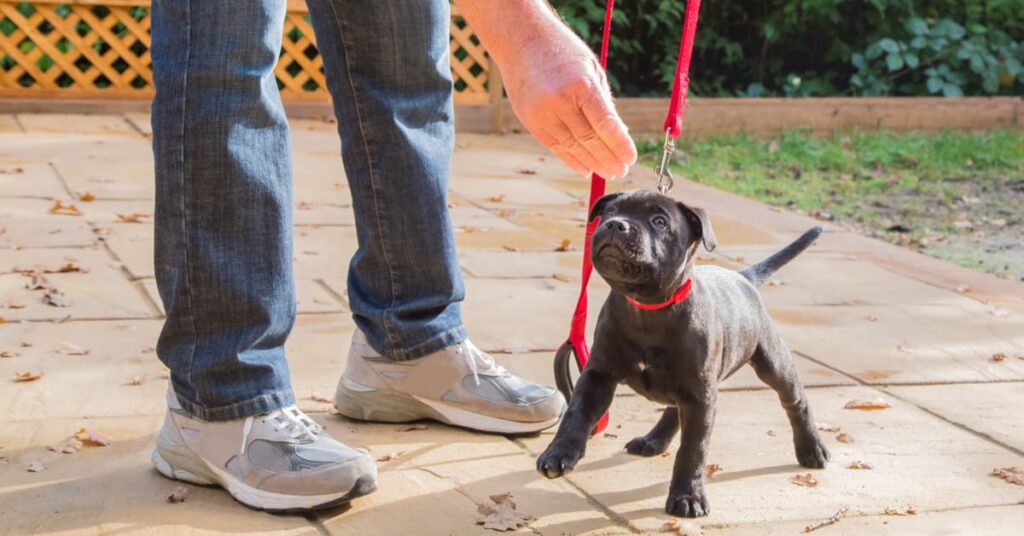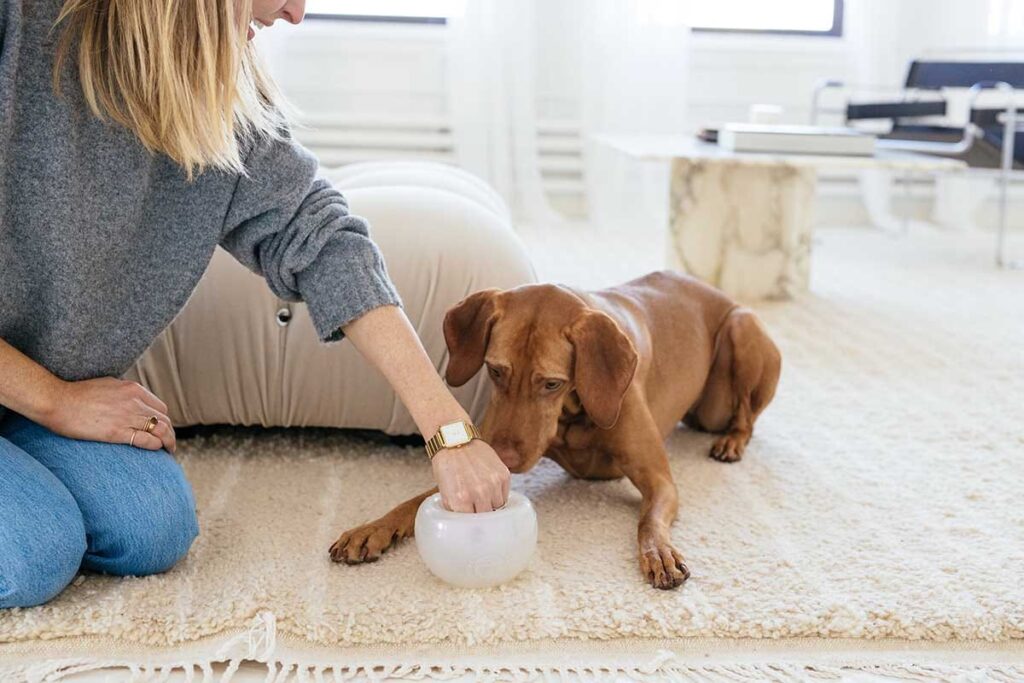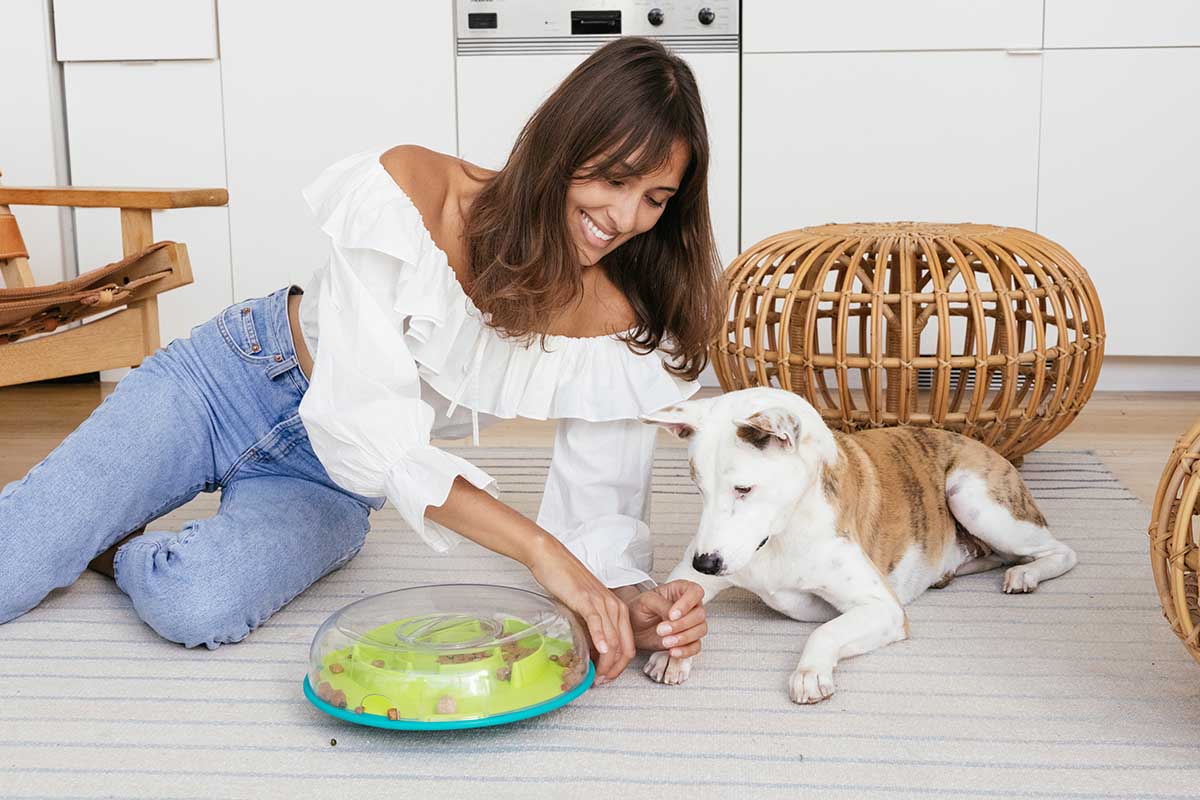Dogs love learning and it’s up to us to make learning fun for them! If you have a new dog, puppy, or dog who you haven’t spent time training, it’s the perfect time to work on foundation skills. Dogs of all ages, sizes, and breeds can and should learn new things.
Teaching foundation skills to your dog is really teaching your dog about learning. This is the bedrock upon which all your future training will be built.
With foundation training, it’s most important to focus on relationship building between dog and guardian.
Why Center Training

Teaching your dog fundamental skills isn’t about forcing your dog to do what you want all the time. It’s about finding ways to strengthen the relationship you and your dog have.
This kind of training will also help you and your dog learn new ways of communicating with each other. By strengthening your communication and relationship you can reduce challenging behaviors and decrease conflict between dogs and people in the home.
Instead of trying to control your dog, training foundation skills gives you the opportunity to work with your dog.
4 Core Foundation Skills To Teach

1. Name Recognition
All dogs should know what their name is. This is one of the first skills that’s useful and easy to teach to a new puppy or dog as soon as you bring them home.
Say your dog’s name and toss a small treat or toy your dog is excited about. Repeat this multiple times over several training sessions and quickly your dog will start making the association that when they hear their name good things happen.
Very soon when your dog hears their name, it will look at you consistently. This is a great way to get your dog’s attention quickly at home and when out on walks.
2. Getting Comfortable Being Handled

All dogs regardless of age, size, or breed benefit from being comfortable with handling and grooming.
Dogs with long fur, or a curly coat will need more intensive grooming, but all dogs need regular grooming. Even short-coated dogs should be brushed regularly to stimulate healthy skin by removing debris and dead hair. In addition, all dogs need their nails trimmed, ears cleaned, and teeth brushed on a regular basis.
Foundation skills can also help prepare your dog for being handled at the vet as well, which allows you to stay on top of your dog’s overall physical health by spotting potential issues early.
Start as early as possible by introducing your dog to the sensation of being handled. Keep your sessions short, praise and reward your dog by gently touching your dog, and then giving it a treat.
3. Play

Often overlooked but just as important as any other skill, it’s valuable that your dog understands how to play, and how to play with you!
Play is a great way to enrich your dog’s life and help you and your dog to communicate better with one another. Play can also be an effective way to help your dog reduce stress levels, decrease boredom, and can be utilized as a reward when training.
Experiment with different kinds of toys and games to get an idea of what your dog likes best. For dogs who are reluctant to engage with toys, it can be useful to invest in toys and puzzles that are treat or food dispensing.
4. Loose Leash Walking

Loose leash walking doesn’t mean that your dog needs to be perfectly at your side in a heel position, rather it’s about walking near you without pulling. This makes walking not only more comfortable for you, but also safer and more comfortable for your dog.
When you take your dog walking be sure that you keep high-value treats in your pocket or in a treat pouch. Start in a low distraction area and reward your dog for being near you. The goal here is to help your dog build an understanding that being near you is a highly rewarding place to be. Soon enough, your dog will begin to offer to stay close to you.
Start rewarding every few steps, then slowly build up to longer walks but continue to reward intermittently.
The environment is always going to be stimulating for your dog with new smells, sounds, and things to see, but the key to teaching loose leash walking is to make yourself more interesting than the environment around you through reinforcement by offering treats, and engagement, play, and praise.
What About Obedience?

You might be surprised obedience skills like sit, down, or stay aren’t included in this list of foundation skills to teach your dog. While these more general obedience behaviors are valuable skills for dogs to have, the above foundation skills lay the groundwork for teaching those other obedience cues.
These foundation skills are about strengthening and developing a relationship with your dog. They also enable you to keep your dog safe by staying with you when out in the world and to keep your dog groomed and cared for with little-to-no stress.
When thinking about foundation training for dogs and puppies, it’s less important how many behaviors a dog knows on cue to start with. Instead, the priority should be the relationship that dog has with their guardian and their overall attitude and perspective on learning and training.
In the long run, you’ll continue your training journey with your dog and teach them new skills built out of these foundations.
Foundation Skills Teaching Methods

When training with your dog it’s important to utilize positive reinforcement-based methodologies.
Don’t punish your dog. Instead, use praise, treats, toys, and play to encourage and reward the behaviors that you do want.
Not only is this an effective way of teaching, but it also helps dogs to become enthusiastic learners.
Behaviors that are reinforced are more likely to be repeated so the best way to train your dog is by utilizing whatever your dog finds reinforcing, generally treats and toys.
When working to teach your dog these foundation skills, or any other training, it’s important to be consistent.
A short training session lasting just a couple of minutes multiple times a day is far more effective for your dog than a long training session every few days.
Being consistent with your training helps your dog to understand skills faster and with less confusion.
Teaching foundation training skills doesn’t mean you will automatically have the most obedient dog in the neighborhood. Rather it is giving you and your dog the basics that allow you to not just coexist but also have fun together.
These are skills that help strengthen your relationship, allow you and your dog to do more things together, and begin to build for your dog the idea that paying attention to you is good, and leads to rewarding activities, treats, and experiences.
Dogs of all ages and training backgrounds can learn these foundation skills. On their own, they can help you have more fun with your dog, or they can be a jumping-off point for teaching your dog more advanced skills including more advanced obedience and dog sports like agility or rally.

